1950s
Won’t need any clothes
I can't find any other information concerning what became of Matthew Wilson. But I assume he ended up at that great nudist colony in the sky.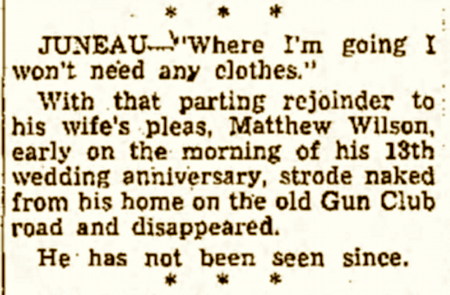
Fairbanks Daily News-Miner (Fairbanks, Alaska) - Dec 19, 1952
However, a search of Alaska papers pulled up this item from earlier the same year (1952), about a Matthew Wilson also in Juneau. So I assume it must be the same guy. Sounds like his circumstances had been difficult before he disappeared naked.
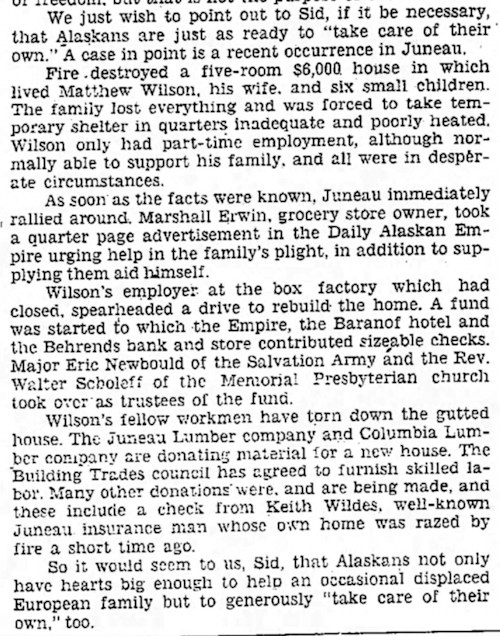
Fairbanks Daily News-Miner - Feb 18, 1952
Posted By: Alex - Tue Dec 15, 2015 -
Comments (5)
Category: 1950s
His wife’s brother was really her husband

A bizarre love triangle on a Wisconsin farm.
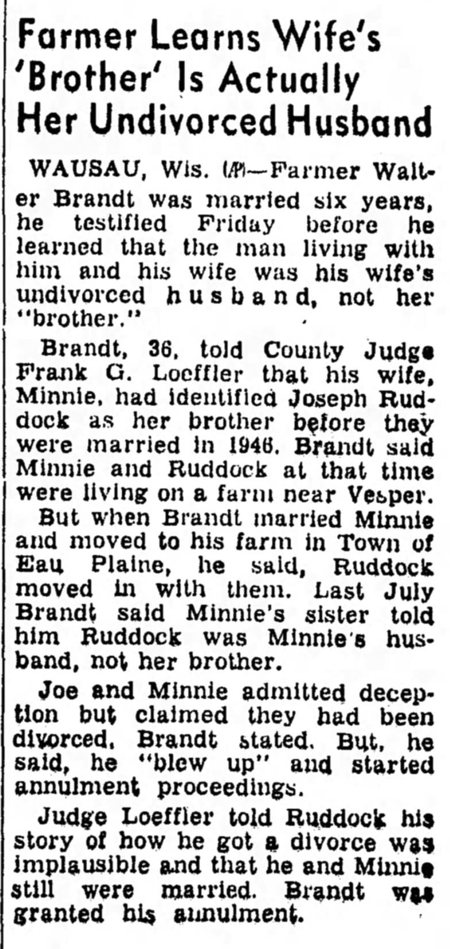
Freeport Journal-Standard - Dec 13, 1952
WAUSAU, Wis — Farmer Walter Brandt was married six years, he testified Friday, before he learned that the man living with him and his wife was his wife's undivorced husband, not her 'brother."
Brandt, 36, told County Judge Frank G. Loeffler that his wife, Minnie, had identified Joseph Ruddock as her brother before they were married in 1946. Brandt said Minnie and Ruddock at that time were living on a farm near Vesper.
But when Brandt married Minnie and moved to his farm in Town of Eau Plaine, he said, Ruddock moved in with them. Last July Brandt said Minnie's sister told him Ruddock was Minnie's husband, not her brother.
Joe and Minnie admitted deception but claimed they had been divorced, Brandt stated. But, he said, he "blew up" and started annulment proceedings.
Judge Loeffler told Ruddock his story of how he got a divorce was implausible and that he and Minnie still were married. Brandt was granted his annulment.
Posted By: Alex - Mon Dec 14, 2015 -
Comments (2)
Category: Marriage, 1950s
Swimsuit became transparent when wet
Mrs. Muncy of Redondo Beach was shocked and humiliated when her white swimsuit got wet and showed everything. So she sued the maker of the suit for $10,000.Unfortunately I can't find any record of the outcome of her lawsuit.
That info is probably available somewhere in the archives of the L.A. County Superior Court, but their archives aren't searchable online. It's too bad that courts, for the most part, don't make any effort to put their archives online. It would be a gold mine for the history of weird news if they did.

Freeport Journal Standard - Nov 19, 1953

LA Times - Nov 19, 1953
Posted By: Alex - Sun Dec 13, 2015 -
Comments (9)
Category: Lawsuits, 1950s
Rare Hallucination
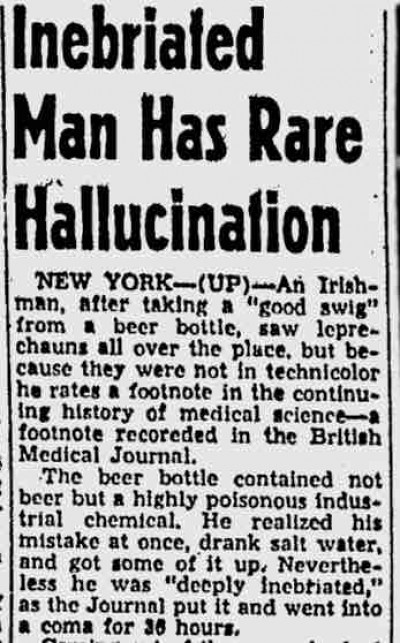
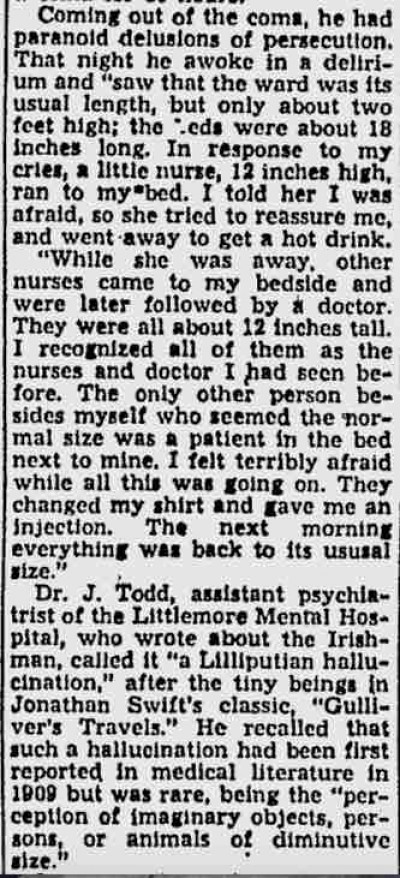
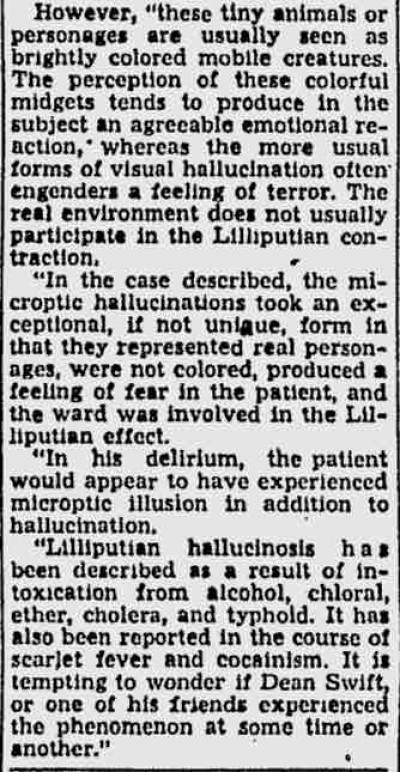
Original article here.
Posted By: Paul - Sun Dec 13, 2015 -
Comments (8)
Category: Dreams and Nightmares, 1950s, Alcohol, Brain Damage
The Duoscopic TV
In 1954, DuMont came out with a "Duoscopic" TV set that allowed two people to watch different programs on the same set, simultaneously. From Newsweek (Jan 11, 1954):It was priced at $600. So in 2015 money, that would be approximately $5304 (according to the US Inflation Calculator). At that price tag, it made more sense for couples with different viewing preferences to just buy 2 TV sets and sit in separate rooms.
There's more info about the Duoscopic TV at the Early Television Museum. On that site, there's also speculation that DuMont originally developed the Duoscopic TV as a 3D TV, but decided they couldn't get that to work fully, so they repackaged it as a "watch 2 channels simultaneously" TV.
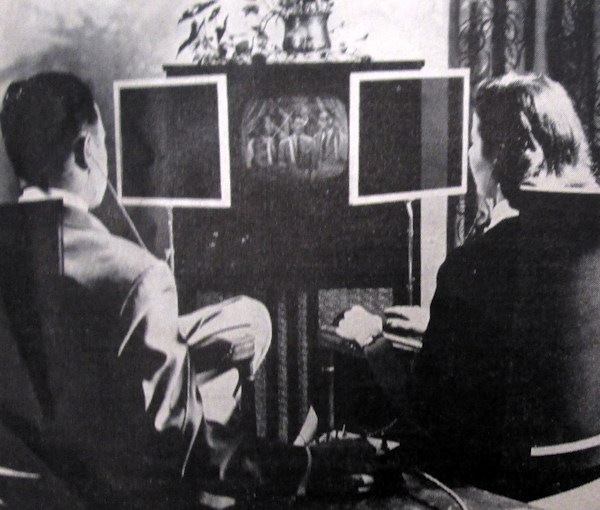
Posted By: Alex - Fri Dec 11, 2015 -
Comments (11)
Category: Technology, Television, 1950s
Big Role for Rock
Here's my question: who the hell ever first thunk up this elaborate, non-intuitive processing of gypsum, a rock out of the ground? The ingenuity of mankind and our genius ancestors is awesome and baffling.
Posted By: Paul - Fri Dec 11, 2015 -
Comments (4)
Category: Technology, Industry, Factories and Manufacturing, 1950s, Natural Resources
Kattle Kaller Auto Horn
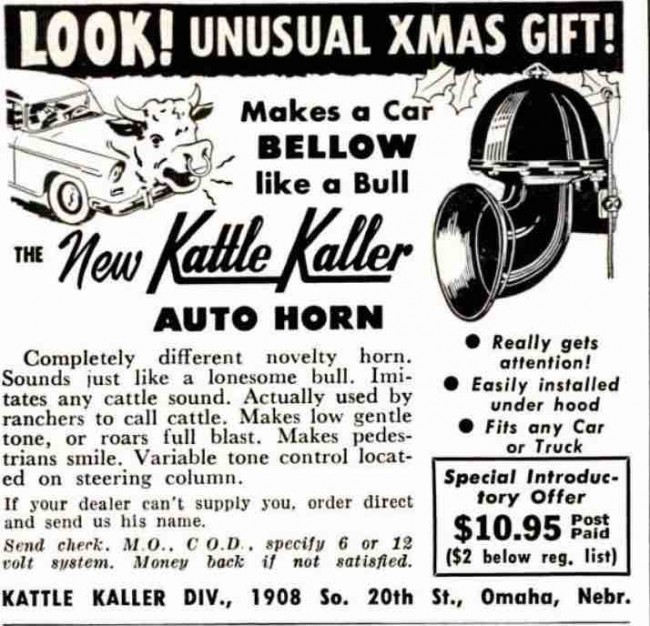
I would definitely buy one of these today.
Given digital technology, would it not be easy to install a speaker under your hood which broadcast an infinite number of digital sound files on command?
Original ad here.
Posted By: Paul - Thu Dec 10, 2015 -
Comments (10)
Category: Animals, 1950s, Cars, Cacophony, Dissonance, White Noise and Other Sonic Assaults
Alaskan Land Train
Built by the US Army in the 1950s, this colossus was designed to transport cargo in the arctic — operating like a train, but without tracks. It was used successfully for over a decade (for the last time in 1962), but was eventually made obsolete by the development of helicopters. Read more about it at Diseno-Art.com.

Posted By: Alex - Fri Dec 04, 2015 -
Comments (8)
Category: 1950s, Trains
Teacher hypnotizes students, 1958
In 1958, Dr. David Briggs claimed that hypnotizing his students increased their academic performance by up to 15 percent.Reminded me of the Hypnotizing High School Principal I posted about back in October. The difference being that in the 1950s a professor hypnotizing his students was seen as a quirky but harmless experiment. But a principal who did essentially the same thing in the 21st Century got accused of contributing to the deaths of his students.

Newsweek - Apr 14, 1958

Valley Morning Star (Harlingen, Texas) - Apr 3, 1958
Posted By: Alex - Thu Dec 03, 2015 -
Comments (9)
Category: Education, Hypnotism, Mesmerism and Mind Control, Psychology, 1950s
Geeky Eyeglasses for Sale
Wow, those are some seriously geeky frames!
I had never heard the phrase "corneal micro lenses" before, but apparently that was the original term for contact lenses. Sounds very cyberpunk even today. I think we should all start telling people, "Yes, I have corneal micro lenses in place."

Posted By: Paul - Wed Dec 02, 2015 -
Comments (3)
Category: Technology, 1950s, Eyes and Vision

| Who We Are |
|---|
| Alex Boese Alex is the creator and curator of the Museum of Hoaxes. He's also the author of various weird, non-fiction, science-themed books such as Elephants on Acid and Psychedelic Apes. Paul Di Filippo Paul has been paid to put weird ideas into fictional form for over thirty years, in his career as a noted science fiction writer. He has recently begun blogging on many curious topics with three fellow writers at The Inferior 4+1. Contact Us |




